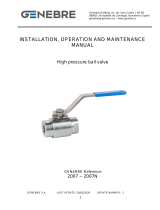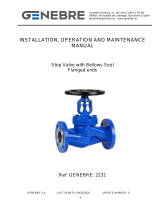Page is loading ...

Genebre Building. Av. de Joan Carles I, 46-48
08908 L'Hospitalet de Llobregat. Barcelona (Spain)
genebre@genebre.es - www.genebre.es
GENEBRE S.A.
LAST UPDATE: 19/02/2021 UPDATE NUMBER: 0
1
INSTALLATION, OPERATION AND MAINTENANCE
MANUAL
Pressure Reducing Valve
with threaded ends
GENEBRE Ref.: 2281

Genebre Building. Av. de Joan Carles I, 46-48
08908 L'Hospitalet de Llobregat. Barcelona (Spain)
genebre@genebre.es - www.genebre.es
GENEBRE S.A.
LAST UPDATE: 19/02/2021 UPDATE NUMBER: 0
2
INSTRUCTIONS FOR INSTALLATION, OPERATION & MAINTENANCE MANUAL
1. Product description ....................................................................... 3
2. Transport and Storage conditions …………….................................... 3
3. Exploded view ......................................................................................... 4
4. Installation Instructions
4.1 Preparation …………………............................................................... 5
4.2 Assembling ……………….………………………………………... 5
4.3 Commissioning ……………….……………………………………. 6
5. Operating Instructions
5.1 Usage ................................................................................................... 6
5.2 Instructions for regulation ..................................................................... 6
5.3 Capacity Chart ..………………….……………………………….. 7
6. Maintenance Instructions ...................................................................... 8
6.1 Cleaning of the Screen, Ball and Seat .................................................. 8
6.2 Replacement of the Regulating Spring .................................................. 8
7. Reparation Instructions ....................................................................... 9
8. Hygiene and Safety Instructions ........................................................... 9

Genebre Building. Av. de Joan Carles I, 46-48
08908 L'Hospitalet de Llobregat. Barcelona (Spain)
genebre@genebre.es - www.genebre.es
GENEBRE S.A.
LAST UPDATE: 19/02/2021 UPDATE NUMBER: 0
3
1. Product description.
Genebre, S.A. offers a wide range of valves designed and assembled to handwheel and
drive fluids in industrial procedures.
The compatibility of materials used to build the valves (see technical specifications) and
the application of valves to the different industrial processes is at user's risk. Valves will
have an optimal behavior when working conditions do not exceed pressure and
temperature limits (pressure curve) for which they have been designed.
2. Transport and Storage conditions
Transport and storage of this kind of products must be done keeping them in their
original package!
VISUAL INSPECTION
Check whether during transport, unloading and placement the products have suffered
damages.
During storage it is recommended to keep them into the included protective wrapping to
avoid damages or dirt accumulation in the inside part of the valve. The wrap must not be
removed until valve is to be installed.
Valves must be stored in a dry and clean environment.
If you notice any kind of anomaly during reception of the goods, contact immediately
with GENEBRE in order to determine the possible responsibilities on the issue.
IMPORTANT NOTE:
Before installing and/or manipulating these elements, READ CAREFULLY these
instructions for use and OBSERVE all contained information. If you fail to
understand any of their content, please contact GENEBRE, S.A.
User is responsible for the safe use of these products, according to present
instructions for use and specific technical documentation of the device.

Genebre Building. Av. de Joan Carles I, 46-48
08908 L'Hospitalet de Llobregat. Barcelona (Spain)
genebre@genebre.es - www.genebre.es
GENEBRE S.A.
LAST UPDATE: 19/02/2021 UPDATE NUMBER: 0
4
3) Exploded view
Nº
Denominación / Name
Material
1
Cuerpo / Body
Acero Inox / Stainless Steel 1.4308 (CF8)
2
Tapa / Cover
Aleación de Aluminio / Aluminium Alloy
3
Tapón / Cap
Acero Inox / Stainless Steel 1.4308 (CF8)
4
Bola / Ball
Acero Inox / Stainless Steel AISI 440
5
Asiento / Seal
Acero Inox / Stainless Steel AISI 304
6
Fuelle / Bellows
Acero Inox / Stainless Steel 1Cr18Ni9Ti
7
Recogedor / Picker
Acero Inox / Stainless Steel
8
Muelle / Spring
Acero para muelle / Spring Steel 60Si2Mn
9
Caperuza / Cap
Acero al Carbono / Carbon Steel
10
Volante / Handwheel
Tecnopolímero / Tecnopolymer
11
Placa / Plate
Acero Inox / Stainless Steel
12
Eje / Stem
Acero Inox / Stainless Steel
13
Tornillo ajuste / Set Screw
Acero al Carbono / Carbon Steel
14
Tamiz / Screen
Acero Inox / Stainless Steel
15
Muelle / Spring
Acero para muelle / Spring Steel 50CrVA
16
Junta / Gasket
PTFE

Genebre Building. Av. de Joan Carles I, 46-48
08908 L'Hospitalet de Llobregat. Barcelona (Spain)
genebre@genebre.es - www.genebre.es
GENEBRE S.A.
LAST UPDATE: 19/02/2021 UPDATE NUMBER: 0
5
4. Installation instructions
4.1) Preparation
Remove any material remains of the valve wrapping.
Serious problems may arise with the installation of a valve in a dirty pipe.
Make sure the pipe is not dirty and doesn’t have welding particles, for example, before
installing it. This may cause irreparable damages in the valve when the equipment is
started → prepare a clean working area.
Plan beforehand enough space for future maintenance operations.
4.2) Assembling
Make sure the valve's pipe and thread end are clean and are compatible one with
another (type of thread end) Apply an appropriate sealing into the pipes' thread ends and
thread the valve being careful not to excessively tighten the conical threaded ends.
To tighten the valve into the pipe it is recommended to use a spanner or monkey wrench
only on the hexagonal area of the valves edges or in the body central assembly; the force
applied needs to be less than 30 Nm.
Design for this kind of valves allows only one position for assembling it to the
pipe, specified by means of an arrow in the valve's body that indicates the
direction in which the fluid needs to circulate.
If possible, it is recommended to install the valve in horizontal position.
Valves do not have to support pipe's efforts, so it is advisable to anticipate a good
alignment and parallelism of such pipe.
It is strongly recommended the use of filters in the pipes (upstream) for better
operation, as well as to prolong the life cycle of the pressure reducing valve. On

Genebre Building. Av. de Joan Carles I, 46-48
08908 L'Hospitalet de Llobregat. Barcelona (Spain)
genebre@genebre.es - www.genebre.es
GENEBRE S.A.
LAST UPDATE: 19/02/2021 UPDATE NUMBER: 0
6
the other hand, it is also recommended to install a pressure gauge and a shut-off
valve both upstream and downstream and isolate the valve by means of a ‘bypass’.
It is important that the length of straight pipe both upstream and downstream is at
least 10 times the diameter of the pipe.
4.3) Commissioning
1- Close the shut-off valves (upstream and downstream) and bypass the steam to
clean the condensate and dirt from the pipeline.
2- Pull the Handwheel (part. 10) of the reducing valve and turn clockwise until the
maximum (this is the factory setting).
3- Open the downstream shutoff valve slightly and then slowly open the upstream
shutoff valve.
4- Now the valve is ready for adjustment or regulation (see section 5.2).
5. Operating instructions
5.1) Usage
Valve materials have to be fully compatible with the fluid circulating through the valve.
Otherwise, valve could be seriously damaged.
The main purpose of pressure reducing valves is to reduce the fluid pressure to optimum
operating values, constantly below the maximum permitted vales so as not to damage
installations after the reducing valve.
The pressure reducing valve of GENEBRE, S.A. art. 2281 is designed for use only with
steam for inlet pressures not exceeding 16 bar. It has a high reduction capacity, the
maximum ratio being approximately 10:1. The standard spring that comes from the
factory is used to regulate the outlet pressure from 2 to 8 bar. For a regulation of 1 to 3
bar, a spring is attached to replace it if necessary. See 6.2) Replacement of the
Regulation Spring.
5.2) Instructions for regulation
The pressure reducing valve is supplied at the minimum regulation pressure (0 or almost
0). To increase the outlet pressure, follow the instructions below:

Genebre Building. Av. de Joan Carles I, 46-48
08908 L'Hospitalet de Llobregat. Barcelona (Spain)
genebre@genebre.es - www.genebre.es
GENEBRE S.A.
LAST UPDATE: 19/02/2021 UPDATE NUMBER: 0
7
a. Prepare the installation as indicated in section 4.3) Commissioning.
b. Pull the Handwheel (part.10) of the valve and turn counterclockwise until the
desired pressure is reached.
c. Fully open the downstream shut-off valve and recheck the outlet pressure. Rectify
if necessary.
d. Once the desired outlet pressure is obtained, release the Handwheel (part 10) so
that it engages and remains locked.
5.3) Capacity Chart
Next diagram shows the discharge capacity of the PRV (art. 2281), with steam, according
to the relationship between the Inlet Pressure (P1) and the Outlet Pressure (P2).

Genebre Building. Av. de Joan Carles I, 46-48
08908 L'Hospitalet de Llobregat. Barcelona (Spain)
genebre@genebre.es - www.genebre.es
GENEBRE S.A.
LAST UPDATE: 19/02/2021 UPDATE NUMBER: 0
8
Example: a valve size 3/4" reducing from 9 bar (upstream) to 3 bar (downstream) is able
to flow until 120 Kg/h of steam, approximately.
6. Maintenance instructions
Frequency, place and process of maintenance will be determined by the user by taking
into account usage of the product.
6.1) Cleaning the Screen (part.14), Ball (part.4) and Seat (part.5)
a. Fix the valve in a clamp with the handwheel facing down.
b. Loosen the Cap (part.3) and remove the Strainer (part.14), the Spring (part.15) and
the Ball (part.4).
c. Unscrew the Seat (part.5) with a spanner.
d. Clean the Screen with water. Use a brush if necessary. Let dry.
e. Clean the Ball and the Seat gently with water with a non-metallic brush if necessary.
Let dry.
f. Reassemble the Seat, Ball, Spring, Screen and Cap, taking care of the Gasket
(part.16).
6.2) Replacement of the Regulating Spring (part.8)
a. Fix the valve in a clamp with the Handwheel facing up.
b. Decompress the spring by turning the Handwheel counterclockwise.
c. Unscrew and remove the Cover (part.2) + Handwheel (part.10) using a wrench.
d. Replace the Spring (part.8) with a spare one that is suitable for the required
regulation pressure. Use only original spare parts from GENEBRE, S.A.
Before disassembling the pipe's valve to clean or replace it, make sure that line
has been closed and depressurized because a bad operational procedure could
cause a serious accident to staff and installation system

Genebre Building. Av. de Joan Carles I, 46-48
08908 L'Hospitalet de Llobregat. Barcelona (Spain)
genebre@genebre.es - www.genebre.es
GENEBRE S.A.
LAST UPDATE: 19/02/2021 UPDATE NUMBER: 0
9
e. Reassemble the Cover (part.2) + Handwheel (part.10) using a wrench.
7. Reparation instructions
These types of valves, due to their assembling specifications are not worth repairing,
because most of the times are simply not cost-effective, so we recommend to directly
replace them.
However, in case that the Regulation Spring (part.8) is damaged, proceed to replace it as
explained in section 6.2.
8. Hygiene and Safety Instructions:
8.1) Fluids that go through a valve can be corrosive, toxic, flammable or pollutant. They
can also be found at very high or low temperature. When operating valves, you must
follow the security instructions and it is recommended to use personal protection gadgets:
1) Protect your eyes.
2) Wear gloves and appropriate working clothes.
3) Wear safety footwear.
4) Wear a helmet.
5) Have running water at hand.
6) To operate flammable fluids, make sure you have an extinguisher at hand.
Before removing a valve from a pipe, always check if the line is completely
drained and depressurized.
8.2) Always operate the valve in open position to make sure there is no pressure in the
internal cavity.
8.3) Any valve being used by toxic services department needs to obtain a cleanliness
certificate before being operated.
8.4) Any type of repair or maintenance should be performed in ventilated places.
Before installing new valve, check if it meets the requirements of the valve
being replaced
/









